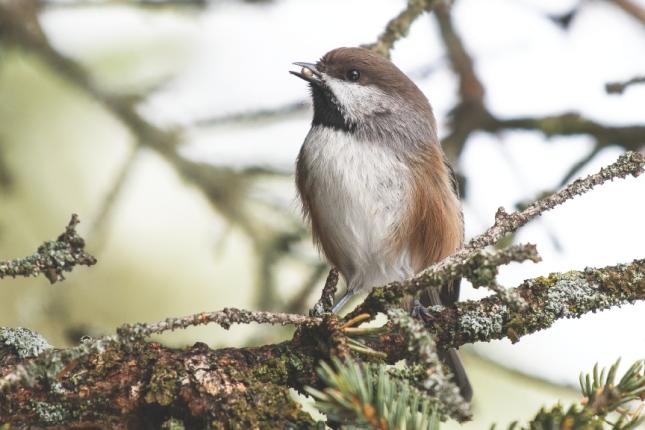Fun Facts About Chickadees

Boreal Chickadee
- Chickadees are found across much of North America. The more common species include the Black-capped, Carolina and Mountain Chickadees.
- Boreal Chickadees are rarely seen at feeders except in Alaska and Canada.
- The Boreal commonly chooses cache sites on the underside of branches, perhaps because snow covers upper surfaces.
- Chickadees usually mate for life.
- Only about 20% of the Black-capped’s daily energy intake comes from feeders, and about half of the overall winter diet is made up of such animal matter as spiders, dormant insects, and even carrion.
- In early summer, Mountain Chickadees are able to find and use seeds they hid during the previous autumn.
- Black-capped chickadees keep an eye on the food-finding success of other individuals, if one bird is doing especially well; they adapt their behaviour, whereas unproductive tactics are not copied.
- Chickadees are easily identified by their namesake call “chick-a-dee.”
- They are a favourite feeder bird for many and really enjoy sunflower seeds.
- They are inquisitive and found in wooded areas.
The Black-capped generally sings out a “fee-bee” call while the Carolina Chickadee sings “fee-bee fee-bay;” however, this song is learned and, in overlapping territories, may be learned from the “wrong” bird.
- Chickadee’s wing beats are about 27 times per second. This compares to a hummingbird’s 80 beats per second.
- They are cavity nesters. They will excavate their own nest site in a rotten or decaying wood, use an old woodpecker hole or use a nesting box. Put some wood chips in your nesting box and watch the chickadee "excavate" the chips.
- Usually lay 6–8 white eggs with a light reddish-brown speckling.
- They hatch in about 12 days and fledge about 21 days later.
- Research has shown that while Chickadees are regular visitors to feeders, over 75 to 80 percent of their winter food supply still comes from natural sources.
- When the temperature falls below -12 degrees C, research has shown that the survival rate of chickadees almost doubled when they had access to feeders, this resulted in an overall higher winter survival rate of 69% versus a 37% survival rate for populations without access to feeders.
- Have you noticed how ravenously the birds eat at your bird feeders, especially first thing in the morning and just before dusk? Chickadees can gain as much as 10 percent of their body weight each day and lose it all again during a cold winter night.
Chickadees are a tough little bird that do not migrate. During cold weather Chickadees have been found to need twenty times more food than they do in summer.
- They like to eat seeds, suet and even coconut.
- Chickadees weigh less than one-half of an ounce.
- The oldest banded Black-capped Chickadee recaptured in the wild had lived 12 years and 5 months.
- The oldest banded Carolina Chickadee recaptured in the wild had lived 10 years and 11 months.
- The oldest banded Mountain Chickadee recaptured in the wild had lived 10 years and 1 month.
- Each year in the Christmas Bird Count, Edmonton regularly counts more Black-capped Chickadees than other areas.

